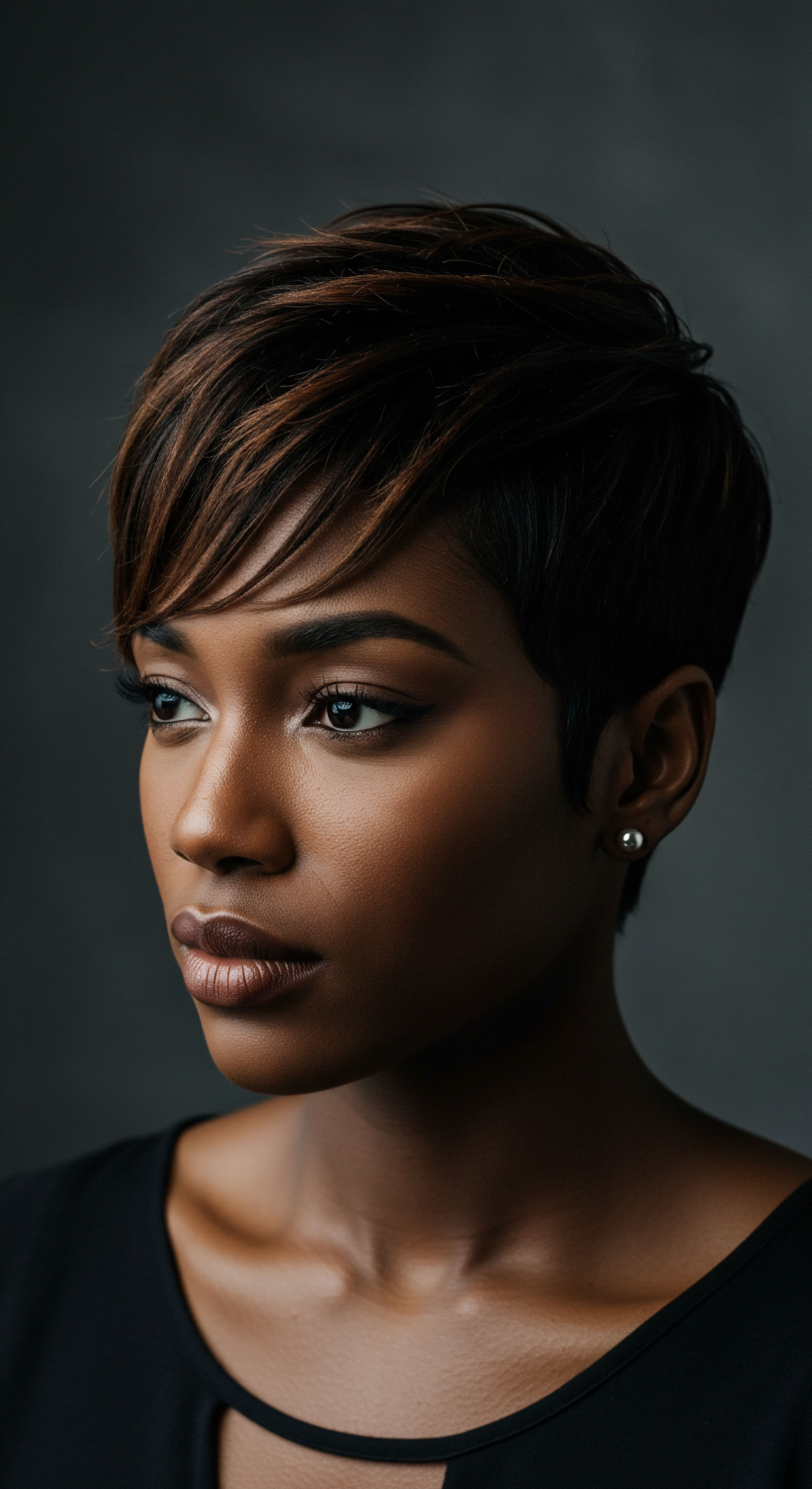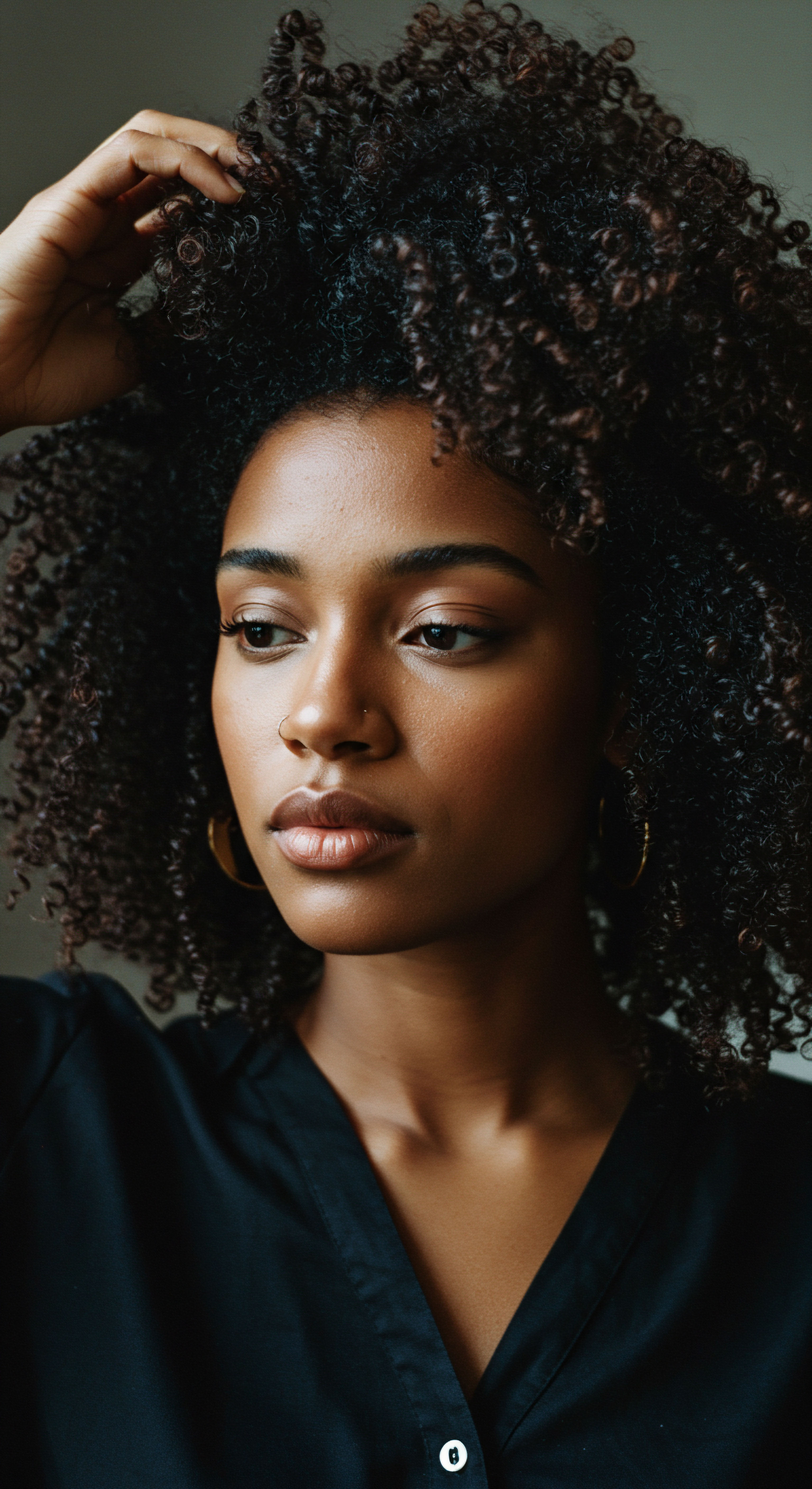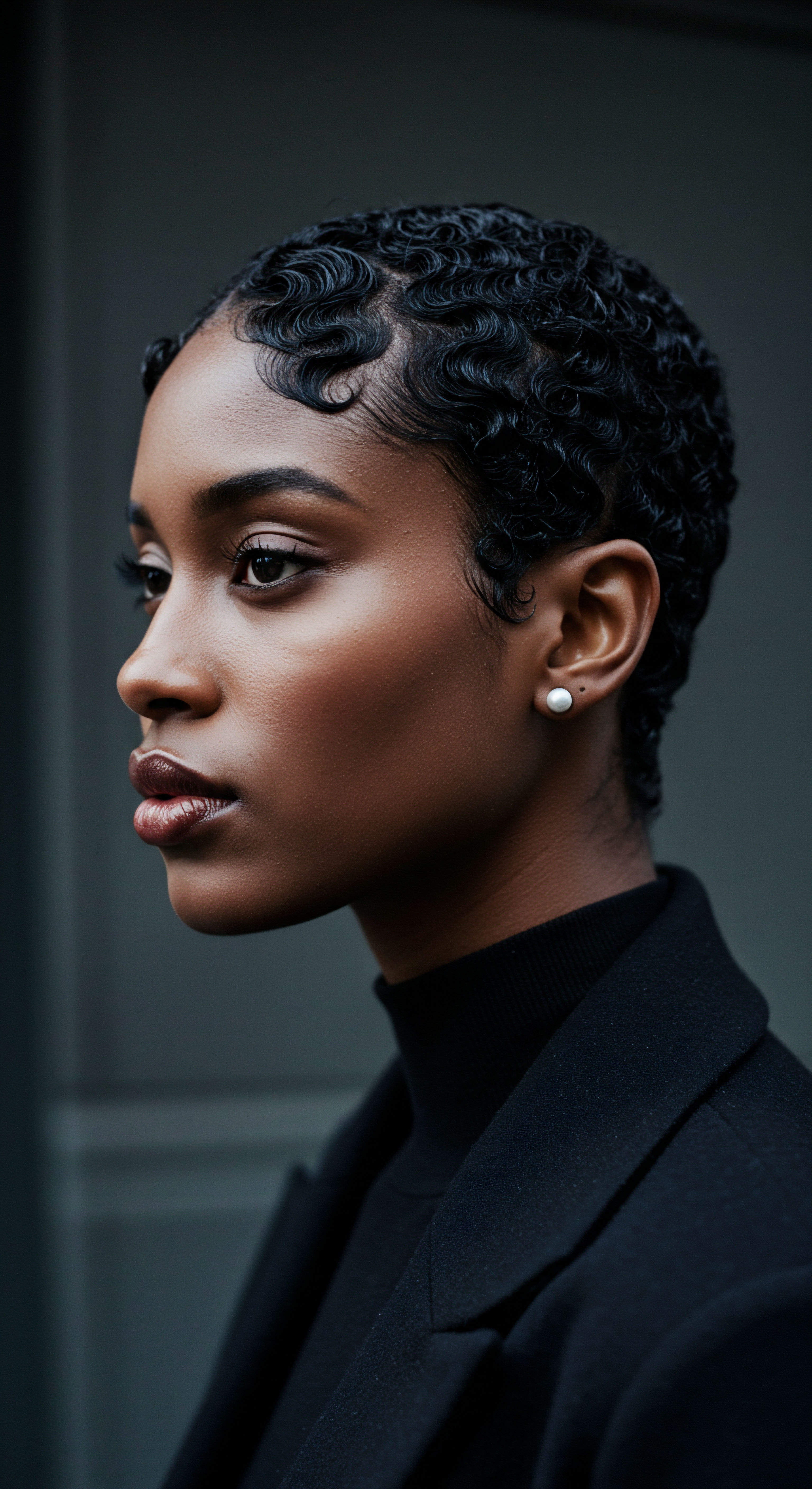
Roots
Consider the quiet strength held within a single strand of hair, not merely as a physical attribute, but as a living connection to something far grander. For historical African communities, hair was precisely this ❉ a profound conduit, a living symbol that whispered tales of ancestry, social standing, and spiritual alignment. It was a language spoken without words, its every twist, braid, and adornment a deliberate pronouncement in the world and beyond. The relationship between people and their hair was not a casual one; it was deeply ingrained, reflecting a worldview where the visible and invisible realms often converged.
Across the diverse continent, from the earliest civilizations to the great empires, hair served as a central point of cultural and spiritual expression. Its placement at the highest point of the body, the head, often linked it directly to the divine and the cosmic. This physical elevation translated into spiritual significance, positioning hair as a receiver of divine energy and a medium for communication with ancestral spirits. The care, styling, and adornment of hair were not simply acts of beauty; they were sacred practices, mindful interactions with a potent spiritual extension of the self.

Hair as a Spiritual Antenna
Many African traditions viewed hair as an extension of the soul, a highly sensitive organ capable of receiving and transmitting spiritual messages. This concept, often likened to an antenna, suggested that hair could pick up vibrations and insights from the spiritual realm, connecting the individual to a broader cosmic consciousness. This belief explains why particular care was given to hair, and why its manipulation was often reserved for trusted individuals within the community. The very structure of textured hair, with its unique coils and patterns, was sometimes seen as inherently attuned to these subtle energies.
Hair, particularly when allowed to grow naturally, was perceived as a spiritual antenna, linking individuals to the divine and ancestral wisdom.
The notion of hair as a spiritual receiver was not abstract; it influenced daily practices and communal norms. For instance, the Yoruba people of Nigeria held the head, or ‘ori,’ as the seat of a person’s destiny and spiritual essence. Hair, as the covering of the ‘ori,’ thus inherited immense spiritual value.
Styling hair became a ritualistic act, a way to honor the head and, by extension, one’s destiny and spiritual connections. This reverence meant that hair was rarely treated with indifference; instead, it was approached with respect, understanding its role in a person’s spiritual well-being.

Cultural Indicators on the Head
Beyond its spiritual reception capabilities, hair also functioned as a visual encyclopedia of a person’s life and community standing. Hairstyles communicated a wealth of information, making the head a living billboard of identity. This visual language was understood by all members of the community, allowing for immediate recognition of various social markers.
- Age ❉ Different styles marked transitions from childhood to adolescence, adulthood, and elder status. Young girls might wear specific braids, while married women adopted more elaborate coiffures.
- Marital Status ❉ A person’s relationship status was often openly displayed through their hair. In some cultures, single individuals wore their hair in particular ways, distinct from those who were married or widowed.
- Social Standing ❉ The complexity, adornment, and sheer volume of a hairstyle could indicate wealth, royalty, or leadership roles within a tribe or kingdom. Elaborate styles often required significant time and resources, reflecting the wearer’s status.
- Tribal Affiliation ❉ Specific braiding patterns or hair adornments were unique to particular ethnic groups, serving as a clear identifier of one’s lineage and community. The Fulani, Himba, and Wolof are examples of groups known for their distinct hair expressions.
- Religious Association ❉ Certain spiritual practices or devotion to particular deities might require specific hairstyles, linking an individual directly to their spiritual path.
This intricate system of communication meant that hair was not merely an aesthetic choice but a deeply embedded aspect of social structure and spiritual life. A change in hairstyle could signify a life event, a shift in status, or even a statement of defiance, as seen historically during periods of colonial oppression where forced hair shaving aimed to strip identity.
| Aspect Conveyed Social Rank |
| Description Indicated position, wealth, or leadership within the community. |
| Example Cultures Yoruba, Benin Kingdom |
| Aspect Conveyed Life Stage |
| Description Signified age, coming-of-age, or transition to new roles. |
| Example Cultures Maasai, Akan |
| Aspect Conveyed Spiritual Connection |
| Description Linked individuals to the divine or ancestral spirits. |
| Example Cultures Yoruba, Maasai |
| Aspect Conveyed Group Identity |
| Description Identified tribal or ethnic belonging. |
| Example Cultures Fulani, Himba, Wolof |
| Aspect Conveyed Hair provided a visual language for identity and spiritual connection across many African communities. |

Ritual
To truly appreciate the deep significance of hair in historical African communities, we turn our attention from its foundational meanings to the practices that brought those meanings to life. It is within the daily acts of cleansing, adorning, and shaping hair that we find the heart of its spiritual connection. These were not casual routines; they were deliberate, often communal, acts that reinforced beliefs about protection, identity, and the flow of cosmic energy.
Consider the quiet focus of hands meticulously parting and braiding, or the shared laughter echoing through a gathering as styles took form. These moments were practical, yet profoundly sacred.
The practical wisdom surrounding hair care was passed down through generations, often during these very styling sessions. Recipes for natural conditioners, methods for maintaining healthy strands, and the symbolism of various adornments were all shared, creating a rich oral tradition. The rituals surrounding hair were deeply integrated into the fabric of daily life, serving not only aesthetic purposes but also reinforcing social bonds and spiritual principles.

Why Were Hair Styling Sessions Communal?
Hair styling in many African communities was a highly social and communal affair. It was common for mothers to braid their daughters’ hair, for sisters to style each other’s, or for community members to gather, sharing stories and wisdom as hands worked on heads. This communal aspect reinforced the idea that hair was not merely an individual possession but a shared cultural asset, reflecting the interconnectedness of the community. These sessions were spaces of bonding, where knowledge was transmitted, traditions were upheld, and relationships were strengthened.
The physical act of touching another’s head, often considered the most sacred part of the body, was an intimate gesture of trust and care. This intimacy transformed styling into a ritual of connection, both human and spiritual. It allowed for the sharing of personal narratives, the imparting of advice, and the quiet reinforcement of communal values. The rhythmic motions of braiding or coiling could themselves become meditative, creating a calm atmosphere conducive to spiritual reflection and shared experience.

Adornment and Protection
The adornment of hair held significant spiritual weight. Beyond beauty, materials like beads, cowrie shells, and clay were incorporated into hairstyles for specific protective or symbolic purposes. These elements were often chosen for their perceived spiritual properties, acting as amulets or conduits for beneficial energies.
For example, the Himba people of Namibia traditionally coated their dreadlocked styles with a paste of red ochre, butter, and herbs, symbolizing their connection to the earth and their ancestors. This practice served not only as a cosmetic enhancement but also as a protective layer, both physical and spiritual.
Hair adornments, from beads to ochre, were not just decorative; they were potent symbols of spiritual protection and cultural connection.
Certain materials were believed to ward off negative influences or attract positive ones. The careful placement of shells or specific types of beads could be a form of spiritual shielding, safeguarding the wearer from harm. This practice speaks to a worldview where the physical body, particularly the hair, was seen as permeable to spiritual forces, requiring deliberate measures to maintain balance and well-being.

Hair and Life Transitions
Hair rituals often marked significant life transitions, acting as visible markers of new stages of existence. These rites of passage underscored the spiritual importance of hair in a person’s journey.
- Birth and Childhood ❉ In some traditions, a child’s first haircut was a momentous occasion, signifying their entry into the community or a symbolic cleansing.
- Coming of Age ❉ For young people transitioning into adulthood, specific hairstyles or hair ceremonies were common. These could be elaborate, signifying readiness for marriage, new responsibilities, or spiritual initiation. For instance, in the Wolof culture of Senegal, young girls would partially shave their heads to indicate they were not yet of marriageable age.
- Marriage ❉ Marital status was frequently communicated through specific hairstyles, often involving coverings or intricate arrangements that symbolized a woman’s new role and identity within her husband’s family.
- Mourning ❉ During periods of grief, hair practices often shifted dramatically. Neglecting hair, shaving it completely, or adopting disheveled styles could outwardly express deep sorrow and a withdrawal from social norms. This was a visual representation of a spirit desolated by loss.
These practices illustrate how deeply integrated hair was into the cyclical nature of life, death, and rebirth within African spiritual frameworks. The manipulation of hair became a physical manifestation of internal states and societal roles, linking the individual’s experience to the broader spiritual narrative of their community.

Relay
How do the spiritual beliefs surrounding hair truly intersect with the scientific understanding of our strands, and what complex cultural dialogues does this intersection provoke? We move now to a deeper consideration of how ancient wisdom, scientific observation, and historical experience combine to shape the profound reverence for hair in African communities. This is where the subtle interplay of ancestral knowledge and contemporary understanding creates a richer appreciation for what our hair truly represents. It invites us to consider the intricate ways in which cultural memory is passed down, not just through stories, but through the very fibers of our being.
The significance of hair in African spiritual traditions is not merely a collection of isolated customs; it forms a coherent philosophical system that views the body as a holistic entity, deeply connected to the cosmos. This contrasts sharply with some Western dualistic views that separate mind and body. In many African ontologies, the physical hair is a tangible representation of an individual’s spiritual standing, their connection to their lineage, and their place within the universal order.

Hair as a Bio-Spiritual Conductor
The idea of hair as a conduit for spiritual energy finds a compelling parallel in some contemporary understandings of the human body’s electrical and sensory systems. While traditional African beliefs speak of ‘cosmic energy’ or ‘life force’ flowing through hair, modern science acknowledges hair’s connection to the nervous system. The hair follicle, embedded in the skin, is richly supplied with nerves, making it a sensitive organ. This sensory capacity, in traditional thought, extended beyond mere touch to a reception of unseen energies.
For example, some traditional African beliefs suggest that the spiral shape inherent in textured hair, particularly in its natural, coiled state, mimics natural phenomena such as cyclones, water currents, and even galaxies. This morphological similarity was not seen as coincidental but as evidence of hair’s alignment with universal creative principles. The very structure of Afro-textured hair, therefore, was perceived as optimized for spiritual reception, acting as a natural antenna. This perspective offers a fascinating convergence of observed biological form and deeply held spiritual meaning.
The spiral structure of textured hair, seen in some African spiritual traditions as mirroring cosmic patterns, underscores its role as a powerful receiver of life force.

The Dehumanizing Impact of Hair Shaving During Slavery
The spiritual importance of hair in African communities takes on a particularly poignant dimension when examining the historical trauma of the transatlantic slave trade. A common practice by slave traders was the forced shaving of captured Africans’ heads upon their arrival in the Americas. This act, often rationalized as a measure for sanitation, was a calculated and deeply dehumanizing strategy.
For people who viewed their hair as a repository of identity, status, and spiritual connection to ancestors and the divine, this forced shaving was an act of profound psychological and spiritual violence. It was a deliberate attempt to strip individuals of their cultural identity, sever their perceived connection to their heritage, and break their spirit. As Lori Tharps, co-author of ‘Hair Story ❉ Untangling the Roots of Black Hair in America,’ notes, hair was “a physical manifestation of our rebellion” for enslaved Africans, and its removal was a direct assault on that sense of self.
This historical trauma underscores the depth of spiritual attachment to hair. The act of forcibly removing it was understood as an attempt to disconnect individuals from their spiritual grounding, leaving them vulnerable and disoriented. Even when hair grew back, the enslaved often lacked the traditional tools, oils, and communal practices to care for it, further isolating them from a central aspect of their cultural and spiritual lives. This deliberate erasure highlights the immense spiritual value placed on hair in the communities from which these individuals were stolen.

Can Hair Loss or Changes Carry Spiritual Weight?
Given the profound spiritual beliefs surrounding hair in historical African communities, it follows that hair loss or significant changes in hair condition could carry considerable spiritual or symbolic weight. Beyond mourning practices where hair might be cut, unintentional hair loss or changes in texture could be interpreted through a spiritual lens.
In some belief systems, hair thinning or breakage might have been seen as a sign of spiritual imbalance, a weakening of one’s connection to protective energies, or even the result of malevolent spiritual forces. Conversely, the deliberate cultivation of long, healthy hair, particularly dreadlocks, was often associated with heightened spiritual awareness and power. For instance, among some Maasai and Samburu tribes, dreadlocks (‘ojwang’ or ‘olusungu’) were not only symbols of strength and wisdom but also represented a sacred gift from the creator, signifying a connection to ancestral heritage. The very act of allowing hair to coil and mat naturally was a spiritual commitment, a way to channel cosmic energy.
A study on the ontology of hair in African literature by Fashola and Abiodun (2018) points out that in traditional Yoruba culture, women were often forbidden from cutting their hair unless widowed, signifying the hair’s role as a “crown of glory” and a marker of status and life cycle. This suggests that unsolicited hair changes, or those outside of ritual context, could indeed hold negative connotations. While direct statistical data on the spiritual interpretation of specific hair conditions in historical contexts is scarce due to the oral nature of many traditions, the consistent emphasis on hair as a spiritual barometer strongly implies that its state was always observed with meaning. The modern phenomenon of “hair discrimination,” where natural African hair is deemed “unprofessional” or “dirty” in some contexts, can be seen as a continuation of historical attempts to disconnect Black individuals from their hair’s inherent cultural and spiritual value, leading to identity crises as discussed in works like Chimamanda Adichie’s ‘Americanah.’ This underscores how deeply intertwined hair is with self-perception and cultural belonging.
| Hair State/Practice Long, Full Hair |
| Spiritual/Cultural Interpretation Fertility, vitality, spiritual strength. |
| Significance Sign of well-being and divine favor. |
| Hair State/Practice Dreadlocks |
| Spiritual/Cultural Interpretation Heightened spiritual connection, wisdom, commitment to spiritual path. |
| Significance Antenna for cosmic energy, link to ancestors. |
| Hair State/Practice Shaved Hair |
| Spiritual/Cultural Interpretation Mourning, humility, spiritual cleansing, or forced dehumanization. |
| Significance Marks significant life events or oppressive acts. |
| Hair State/Practice Adorned Hair |
| Spiritual/Cultural Interpretation Protection, status, spiritual offerings, beauty. |
| Significance Amuletic qualities, communication of identity. |
| Hair State/Practice The condition and styling of hair consistently reflected inner states and outer connections. |

Reflection
As we consider the profound and layered spiritual beliefs surrounding hair in historical African communities, a clear picture emerges ❉ hair was, and remains, far more than a simple biological outgrowth. It stands as a living testament to identity, connection, and a deep reverence for the seen and unseen worlds. The echoes of these ancient practices resonate today, reminding us that our textured strands carry stories, heritage, and a powerful, unspoken language. Each coil and curl holds a memory, a legacy of wisdom passed through generations, inviting us to look upon our own hair with a renewed sense of wonder and respect.

References
- Omotoso, Sharon Adetutu. “Gender and Hair Politics ❉ An African Philosophical Analysis.” Journal of Pan African Studies, 2018.
- Oforiwa, Alice. “The History and Culture of African Natural Hair ❉ From Ancient Times to Modern Trends.” AMAKA Studio, 2023.
- Afriklens. “African Hairstyles ❉ Cultural Significance and Legacy.” Afriklens, 2024.
- Fashola, Joseph O. and Abiodun, Hannah O. “The Ontology of Hair and Identity Crises in African Literature.” IASR Journal of Humanities and Social Sciences, 2018.
- Byrd, Ayana, and Tharps, Lori L. “Hair Story ❉ Untangling the Roots of Black Hair in America.” St. Martin’s Press, 2001.
- Matjila, Chéri R. “The Meaning of Hair for Southern African Black Women.” University of the Free State, 2020.
- Khumbula. “A Crowning Glory ❉ Hair as History, Identity, and Ritual.” Khumbula, 2024.
- Okan Africa Blog. “The Significance of Hair in African Culture.” Okan Africa Blog, 2020.
- Jimi Heaven. “Natural Black Hair and Its Connection to Cosmic Spirituality.” GoNevis, 2021.
- Safo Hair. “Unveiling the Significance of Hairstyles in Black Communities.” Safo Hair, 2024.
- McDowell, Kimberly. “HairStorical ❉ A Journey Through the African Black Hair Culture.” Mediyah Inc. 2022.
- Ibaze, Olunosen Louisa. “Crowning Glory ❉ A History of African Hair Tradition.” Africa Is Not A Country Series, 2022.